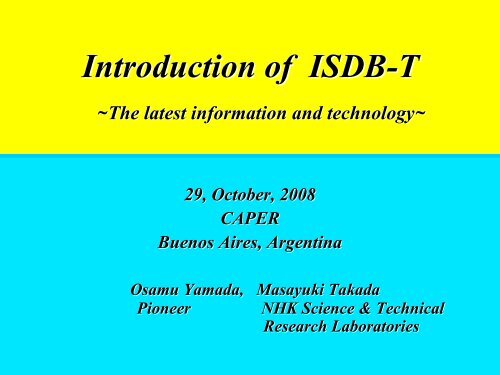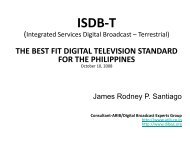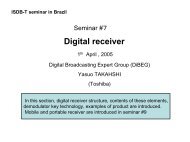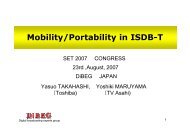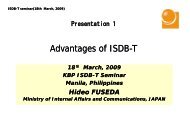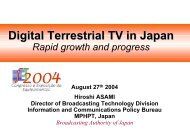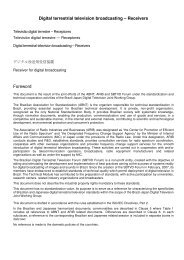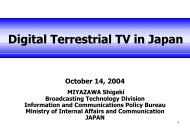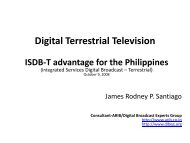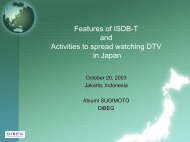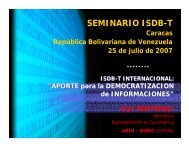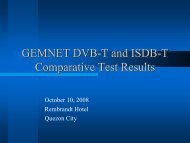Introduction of ISDB-T - DiBEG
Introduction of ISDB-T - DiBEG
Introduction of ISDB-T - DiBEG
Create successful ePaper yourself
Turn your PDF publications into a flip-book with our unique Google optimized e-Paper software.
PCs with <strong>ISDB</strong>-T T tuner (One-SegSeg)Tuner8
USB Type <strong>ISDB</strong>-T T Tuners for One-Seg9
Portable DVD Playerwith <strong>ISDB</strong>-T T tuner (One-SegSeg)10
Other Portable One-SegReceiversPortable Audio PlayerPortable Electronic DictionaryPortable NavigatorPortable TV11
Manufactures <strong>of</strong> Portable One-SegReceiversMobile PhoneCarNavigationPC TunerAudio/DVDPlayerTV/RadioToshiba Panasonic Logitech Sony Sanyo NintendoSharp Fujitsu Buffalo Toshiba Evergreen SonyHitachi Sanyo Greenhouse Panasonic SonyPanasonic Pioneer Sanwa Toshiba LogitechSony Kenwood IO-Data SanyoKyocera Clarion KoregaNEC Mitsubishi PixelaVideo GameFujitsuRockridgeSoundSanyoCasio12
2. System Requirements andTechnologies <strong>of</strong> <strong>ISDB</strong>-T
Features <strong>of</strong> <strong>ISDB</strong>-T~Requirements and Key Technologies~The system requirement was formally approved at the meeting<strong>of</strong> Technical Communication Council in 1994.(1) System flexibility :Segmentation, Hierarchical transmission(2) Robustness against impulse noise and multi-pathinterference :BST-OFDM, Time interleaving(3) Mobile reception :BST-OFDM, Time interleaving,(4) Portable reception :BST-OFDM, Time interleaving, One seg(partial reception)(5) Effective frequency usage :SFN(6) Compatibility with digital radio services :Segmentation14
2.1OFDM
OFDM SignalsTime domain signal<strong>of</strong> OFDM wave++Carrier 1Carrier 2Frequency domainsignal <strong>of</strong> OFDM wavef1f2++OFDM was presented by Mr.Hirosaki(NEC) for the first inthe world.OFDM is++=Carrier kTransmissionsignalFs++=fk• Multi-carrier modulation– More than 2,000 carriers in a6MHz TV channel– Long symbol durationcompare to single-carriertransmission systemGI(Ts)Active symbolOFDM duration symbolf1, f2, f3, fKMagnitude• Multipath pro<strong>of</strong> modulation– by adding guard intervalFs=1/TsSpectrumFrequency• Modulation/demodulation1616
Superiority <strong>of</strong> OFDM10-1●QPSK○ ○ ○ ○ ○ ○BER10101010-2-3-4-5●●●No GhostOFDM●●(dB)D/U01020304005 10Delay (μs)Multipath Pr<strong>of</strong>ile5 8 11 14 17Eb/NO17
2.2 Segmentation
System for Mobile and Portable Reception~Segmentation~AudioProgramHi-VisionProgramTelevision Broadcast(<strong>ISDB</strong>-T)Simple TV(Mobile)Standard TV(Mobile)Standard TV(Home)Audio Broadcast(<strong>ISDB</strong>-Tsb)AudioProgramAudioProgramData,etcDataSegmentOFDF SegmentTransmissionSpectrumPartial ReceiveTerrestrial Digital Television ReceiverOne-seg& Terrestrial Digital Audio Receiver19
Services <strong>of</strong> <strong>ISDB</strong>-TTV station6MHz13 SegmentsSupport 3 reception typesby one channel<strong>ISDB</strong>-T can also use internetCommunication / InternetMobile/HandheldReception1 segmentFixedReception12 or 13segments13 or 12 + 1segmentsHDTVHome Receiver(diversity reception)Communication carrierHandheld terminalReceiver in Vehicle20
Merits <strong>of</strong> Digital BroadcastingEasy to add new servicesData BroadcastingInteractive TV,e.g. interactive shoppingWeather forecastNewsInformation linkedto on-air programYou can see the productsand you can buy them directly.Digital broadcasting experts group21
Transmission ParametersModeMode 1(Mobile)Mode 2(Mobile, Fixed)Mode 3(Fixed)Number <strong>of</strong> carrier140528094992Carrier distanceValid symbol lengthGuard interval lengthErrorcorrectioninner codingouter codingTime domain interleaveBST-OFDM Segment3.968kHz0.252ms1.984kHz0.504ms0.992kHz1.008ms1/4, 1/8, 1/16, 1/32 <strong>of</strong> valid symbol lengthConvolution coding (1/2, 2/3, 3/4, 5/6, 7/8)Reed-Solomon (208, 188)Convolution 0, 0.1, 0.2, 0.4 second13Hierarchical transmission 3Bit rate 3.65 – 23.23 Mbps22
2.3 Hierarchical Transmission
Information Bit-rate v.s. C/NInformation bit rate (Mbit/s)25201510Guard interval : 1/8QPSK16 QAM64 QAM1/25/6 7/83/42/35DQPSK6dB6dB017.5dB0 5 10 15 20 25C/N (dB)24
2.4 Time Interleaving andMobile Reception
Impulse Noise to Analog TV26
Comparative Test in PeruTest against Impulse Noises from Hair Dryer27
Effect <strong>of</strong> Time Interleaving (1)10 010 -110 -2without time interleavingBER10 -310 -410 -510 -6with time interleavingfd = 7 Hzfd = 20 Hzfd = 70 Hz10 -70 10 20 30 40C/N [dB]28
Why Mobile and Portable Reception(1) All kind <strong>of</strong> TV programs including data services can be receivedat home in the future, via satellite, cable, internet, etc..(2) People’s s outside life times are increasing in the present-day life.(3) Broadcasters have to serve anytime for such people includingvideo, audio, and data.(4) Especially, the emergency information services are veryimportant for people.(5) VHF and UHF band frequencies used by broadcasters, are thebest for mobile and portable reception.(6) In the age <strong>of</strong> the convergence <strong>of</strong> broadcasting andcommunication, Broadcasters can’t t survive without mobile andportable services.29
Field Trials <strong>of</strong> Mobile Reception TVfor the First Time in the World (1993)30
Comparison between Digital(OFDM)and Analog BroadcastingOFDMAnalog31
Effect <strong>of</strong> Time Interleaving (2)Result <strong>of</strong> field trialsCorrect Reception Time Rates (%)10099%959085807570Mode 2, DQPSK, 1/2 , 13 seg.With Time InterleavingWithout Time Interleaving35 40 45 50 55 60 65Measured Field Strength (dBμV/m)32
2.5 SFN(Single Frequency Network)
Reception in SFNCLICLI: Coupling Loop InterferenceNHKDesiredsignalReflected signalNHKSubscriberSFN relaystationCLI CancellationNHKMain stationSea, LakeRelay stationDiversity receptionSubscriberDesiredsignalNHKLarge delay signalSFN stations outside thededicated areaNHKSFN relay stationLarge delay multi-path equalizationSubscriberBy NHK34
Extended Equalization Range10 0 Delay <strong>of</strong> multipath (μs)10 -1D/U=6dBC/N=30dBWithout equalizerBER10 -210 -3Equalizing range <strong>of</strong> delayWith equalizerGITu/810 -40 100 200 300 400 500 600 700 800 900 100035
3. Conclusion
Conclusion(1) The Japanese terrestrial digital broadcasting (<strong>ISDB</strong>-T)had beendeveloped based on a series <strong>of</strong> experiences in developing TELETEXT T andFM multiplex broadcasting systems.(2) <strong>ISDB</strong>-T has a lot <strong>of</strong> merits, system flexibility, mobile and portablereception, SFN, robustness against any interferences etc. which othersystems don’t t have.(3) In Japan, <strong>ISDB</strong>-T receivers have been penetrating fastest in the world, , andthe price is going down rapidly.(4) Brazil decided to adopt <strong>ISDB</strong>-T as their national system in 2006 on theresults <strong>of</strong> comparison <strong>of</strong> three systems, and started it in 2007.(5) Only <strong>ISDB</strong>-T T can satisfy the need <strong>of</strong> all people, and contribute to theimprovement <strong>of</strong> the life <strong>of</strong> all people.<strong>ISDB</strong>-T T is the best.37
Once AgainSince the radio frequencies are the common resources for people, we have touse them usefully.The most effective usage for VHF and UHF is for not fixed but mobile andportable broadcasting.Once we have decided the DTTB system as a national broadcasting standard,we can’t change them anymore. Other two groups have been continuing toimprove their performances.We should select the best system for descendants not to regret and not toaccused <strong>of</strong> it later.Broadcasters are facing on the important time if the services can be extended.We want you in Argentina to use <strong>ISDB</strong>-T not for us but for you. If you select<strong>ISDB</strong>-T, we, the Japanese side will do our best for Argentina.38
Let’s work together towards the future !39


